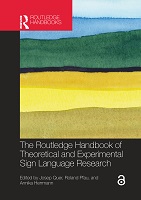Chapter 18 Specificity and Definiteness
Proposal review
Theoretical perspectives
| dc.contributor.author | Barberà, Gemma | |
| dc.date.accessioned | 2023-09-27T12:40:34Z | |
| dc.date.available | 2023-09-27T12:40:34Z | |
| dc.date.issued | 2021 | |
| dc.identifier.uri | https://library.oapen.org/handle/20.500.12657/76454 | |
| dc.description.abstract | While definiteness encodes the information that the sender assumes that the addressee has, specificity encodes the knowledge that the sender has and the anchoring to an item. The chapter focuses on lexical determiners and non-manual marking. As the example below shows, the use of this sign does not have a pejorative meaning, as it can be used in a context where the discourse referent helps the sender. The reading in corresponds to an epistemically specific discourse referent, which is thus identifiable by the sender. The reading in corresponds to an epistemically non-specific and unidentifiable discourse referent. Definiteness and specificity are two interrelated but independent notions. Sign languages are provided with a rich array of lexical signs expressing indefiniteness, but to the best of my knowledge, only few lexical signs have been claimed so far to be specialized for a definiteness. | en_US |
| dc.language | English | en_US |
| dc.subject.other | Experimental, handbook, language, phonological, research, sign, theoretical, comprehension, conventions, interrogatives, | en_US |
| dc.title | Chapter 18 Specificity and Definiteness | en_US |
| dc.title.alternative | Theoretical perspectives | en_US |
| dc.type | chapter | |
| oapen.identifier.doi | 10.4324/9781315754499-18 | en_US |
| oapen.relation.isPublishedBy | 7b3c7b10-5b1e-40b3-860e-c6dd5197f0bb | en_US |
| oapen.relation.isPartOfBook | 3f085e74-5c1f-431c-932e-b2c6d6a41db3 | en_US |
| oapen.relation.isFundedBy | 8ece0728-d36b-453a-b443-5923b97c04c3 | en_US |
| oapen.relation.isbn | 9781138801998 | en_US |
| oapen.relation.isbn | 9780367640996 | en_US |
| oapen.imprint | Routledge | en_US |
| oapen.pages | 21 | en_US |
| peerreview.anonymity | Single-anonymised | |
| peerreview.id | bc80075c-96cc-4740-a9f3-a234bc2598f1 | |
| peerreview.open.review | No | |
| peerreview.publish.responsibility | Publisher | |
| peerreview.review.stage | Pre-publication | |
| peerreview.review.type | Proposal | |
| peerreview.reviewer.type | Internal editor | |
| peerreview.reviewer.type | External peer reviewer | |
| peerreview.title | Proposal review | |
| oapen.review.comments | Taylor & Francis open access titles are reviewed as a minimum at proposal stage by at least two external peer reviewers and an internal editor (additional reviews may be sought and additional content reviewed as required). |

